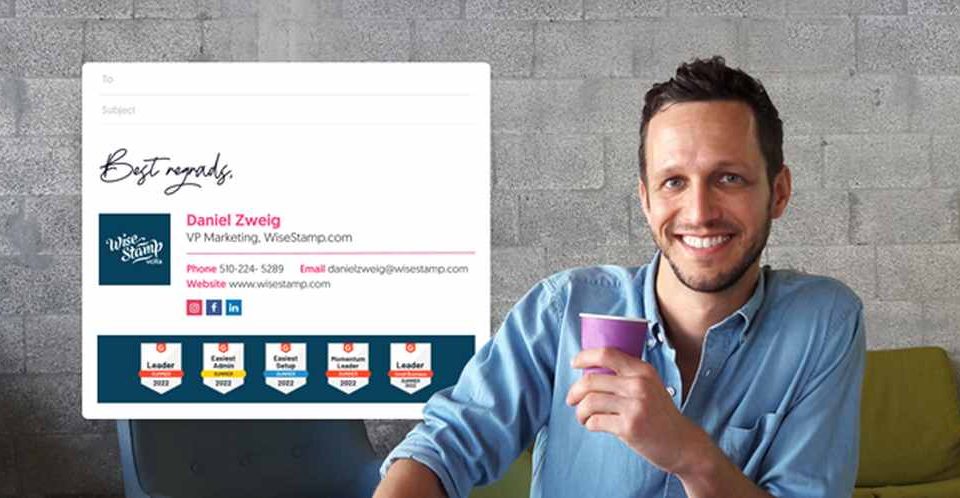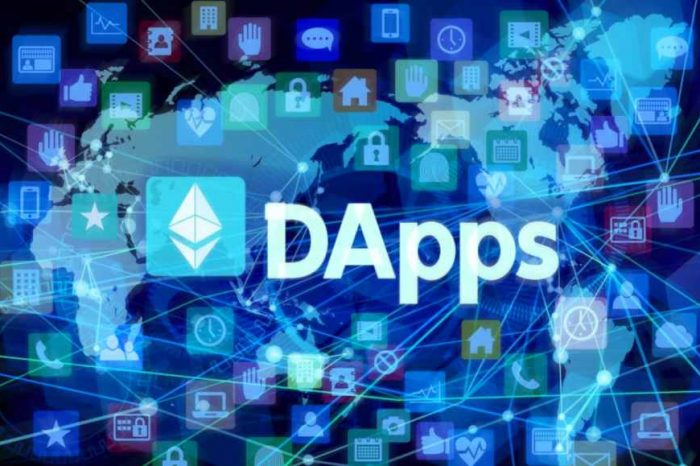CMO Spotlight: Daniel Zweig on the Future of Email Marketing

It’s been a while since we’ve had the Startup Spotlight series where we get into the minds of startup founders, CEOs, and business owners and their stories. The idea behind the series is to give you insights into the mind of great leaders and how they grow their companies so you can learn from their success and ultimately become successful entrepreneurs.
Additionally, we also interview these business leaders to learn about the brief history of their companies, their mission, their products and services, value proposition, and lessons they learned along the way.
Today, we’re excited to have Daniel Zweig, Daniel Zweig, Head of Marketing at WiseStamp, a technology startup company that provides a platform for companies to create email signatures. Thank you Daniel for doing this interview.
Question: You’ve been working in the marketing field since 2011 and worked for major companies like Wix and, now, WiseStamp. Can you introduce yourself and briefly mention a few of your career highlights?
Answer: I’m Daniel, I’ve been managing WiseStamp marketing department for two years now, and before I was responsible for the acquisition and emails departments, but I’ve been in the online marketing industry for over 12 years. I started my journey at K Logic, one of Israel’s leading marketing agencies, and got the opportunity to work with some of the biggest names in tech; Microsoft and the Israeli telecom company Bezeq. I’ve got the opportunity to work on some really big and exciting campaigns, including the Windows 10 launch in Israel.
During my four years with WiseStamp, I’ve watched the company go from strength to strength as we turned WiseStamp into the leading email signature manager for companies all over the world. From the Head of Acquisition to VP Marketing, I’ve tried to do my best to help WiseStamp grow, and I’m really proud to have been a part of it.
Question: Although more people are opening emails during the pandemic, the overall conversion rate for email marketing has fallen since its peak in 2018. So is email marketing going out of fashion?
Answer: Definitely not. I don’t believe email marketing is sustained by fashion. For about 20 years email marketing has been the most ROI-positive way businesses can communicate with their clients. We know over 90% of people check their emails daily, and most of us use email for our most important business communications. As long as that’s true, email marketing will only prosper.
Email is not like social media or a blog, it’s not a place to meet friends, it’s not a place to be entertained, it’s a work tool. So, we are at our most open to making business decisions when we communicate over email. This unlocks significant financial benefits for businesses, with ROI’s, in some instances, as high as 4400%.
More often than you’d think, customers prefer receiving information in their mailbox, as our email has also become our private archive for invoices, documents, etc. And given the right context, people love receiving promotional deals right to their email.
In a nutshell, email marketing is still a big deal; I really don’t see it falling out of use anytime soon. The high conversion rate we get from this channel makes me think the contrary. The dip we see now could be a result of two things. A. The increasing competition on the consumers’ attention as more businesses understand the power of email marketing and B. The development of anti-spam processes in Gmail, Outlook, and other platforms that prevents our marketing emails from reaching their target.
Because of these new anti-spam technologies, I imagine that in the future the email marketing industry will diverge into two main groups; the ‘white hat’ which will do permission-based marketing with double opt-in methods, and the ‘black hat’ who will double down on spamming techniques to get their unsolicited marketing material through spam barriers and into our inbox’s.
Question: There are dozens of email marketing solutions on the market, but we hear much less about Email Signature Marketing tools. WiseStamp has grown really fast offering this solution. So what makes managing your company signatures so attractive for businesses?
Answer: In a high competition market, businesses must find ways to increase their brand exposure, distinguish themselves and build trust with their audience.
An email signature is a little bit like a snapshot of your company. It’s your company’s ID or business card. When someone reads an email sent by your company they would look at the email signature for company assurance, to make sure you are who you are, check your contact information, the social media links, a way to contact your sales, and just to get a general sense of who you are. Knowing this, you have to assume that your email signature frequently makes or breaks the impression you leave on your email recipients. Whether you know it or not, the simple fact that you have an email signature, already means you are doing email signature marketing. So why not take charge of it?
This is where email signature marketing and branding tools like WiseStamp come in handy. An email signature manager will give you control over all your company’s email signatures. This is huge! Once you have that you can brand every email your company sends to establish brand awareness within your audience and increase trust. Beyond email signature branding, email signature marketing tools also permit you to add a button or a banner to help your various departments create relevant call-to-actions, directly in their signature. This can also be used to feature sales campaigns or other promotional initiatives.
Question: Individuals and businesses have to compete to stand out from the crowd in today’s marketing economy. Can you recall a few examples where Wisestamp’s email signatures were used unexpectedly to achieve that?
Answer: We’ve received an abundance of positive feedback about many of our features that help make the email signature more dynamic and eye-catching. For example, using an animated logo or banner, adding one of our animated hand signoffs, or adding a video to employees’ email signatures captures the reader’s attention. Suddenly, the employees’ signatures aren’t just professional-looking but also get more engagement and prime people for taking action.
Question: How do you think the pandemic has affected marketing strategies? Can you predict any new trends emerging in the wake of COVID-19?
Answer: Since the start of the pandemic, marketers have had to adapt, rethink, and manage budget cuts; and I do think some of these changes have the potential to stick. As people spend more time at home, with today’s post-pandemic hybrid work model, we’re online shopping now more than ever. Instead of going to public places, we’ll likely see a steady decline in traditional advertising budgets like billboards, and digital marketing will become more in demand.
Managing the online relationships between businesses and consumers is more critical than ever before. So, I expect more businesses will pay even more attention to their web presence and digital communications with users. For instance, self-serve, increased online purchasing possibilities, and the digitalization of off-line services where possible. In addition, more and more businesses understand that automating processes that used to be done manually is essential for them to meet the communication needs of their users.
Online shopping has always been big, but sales increased massively during Covid. As a result, more businesses realize the importance of improving their online presence and leveraging their analytics to do this.
Another field I predict will be huge in the next few years is TV digital marketing and TV CPM campaigns abilities. But that’s another whole story we’ll have to cover in another discussion.
Question: You’ve worked extensively with small businesses in the past. Now we live in a world where more and more people choose to become self-employed and start their own small businesses. What advice would you give new entrepreneurs navigating marketing strategy for the first time?
Answer: Any good marketing strategy is multifaceted. There are many moving parts to focus on, so building a complete marketing strategy is a long process. I think focusing on each part at a time and understanding that digital marketing is an accumulative process will help new entrepreneurs do things gradually and build their strategies better.
For example, boosting your social media content is a massive one. Start by spending $50 a month, seeing what it brings, then experimenting and trying different things. I’d also advise entrepreneurs to keep a close eye on marketing trends. For example, short video content is enormous at the moment; many businesses are using it to promote their brand.
And capture every opportunity to leave a good impression! It’s vital. For that, a quality email signature will undoubtedly help, but this also means creating a solid email marketing strategy. This involves knowing how to improve audience engagement, open rates, and conversions by monitoring your campaigns and making any necessary adjustments.
Question: What, in your opinion, makes a good quality email signature?
Answer: An email signature is like a modern-day business card. With that in mind, I think any sound email signature should have:
- Links to your social media channels make it easier for recipients to become followers and, hopefully, consumers. It’s also easier for them to find out more about you if they have doubts or feel uncertain about your offering.
- Contact details should be laid out in an easy, accessible manner.
- It should be optimized to work on different email platforms and devices; it needs to look just as stunning on a mobile device as it does on a desktop.
- Be consistent with your brand guidelines (I.e., don’t let employees design their own signatures!)
- Remember to capture and analyze click-data in Google Analytics, so you can track what’s been working and what doesn’t.
Question: What, in your opinion, forms a high-quality email marketing campaign?
Answer: Of course that establishing sending frequency and goals for your campaign and creating a simple and eye-catching design will help you create an effective email flow. But after testing thousands of emails and campaigns, I can say with confidence that one of the most important factors in an email campaign is timing – meaning, what time during the week and during the day you send your email. This has the most meaningful impact on the open and clicks rate, sometimes even more than a better subject line or more engaging email design or content.
Also, a very important tip is you must A/B TEST at every opportunity. Try try try; you never know what you’re going to find out by changing even the smallest things.
Question: How important would you say email automation is to the success of email marketing campaigns?
Answer: Email automation is essential if you’re hoping to run a successful marketing campaign. Today email marketing systems allow marketers to set rules and triggers to help their audience move through their marketing funnel based on their actions. Not only does it save time, but it also makes it easier to scale campaigns and accordingly increase sales. Mostly, because it facilitates more personalization, which, as I’ve already touched on, massively improves the user experience.
Lastly, make sure to utilize social media – use your channels for advertising your products and targeting specific demographics. This makes it easier to reach your audience, giving you a better chance of getting them to sign up for your email list.

